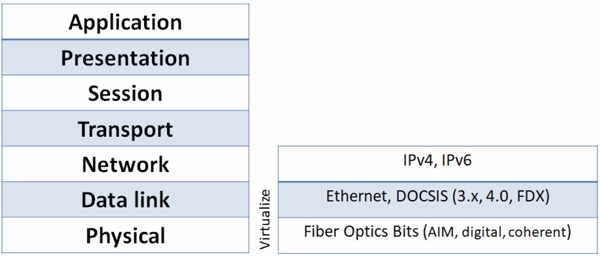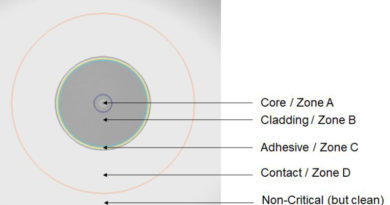An Access Network Evolution with DAA
By Steven Harris
For all the folks supporting the traditional telecommunication access network, or the network connecting our subscribers, the evolution has begun! The priority of reliability, capacity, service quality and reduced latency for the customer experience is top of mind for operators.
Cable folks are very familiar with a central access architecture (CAA) model for service delivery. As a refresher, the CAA model leverages the traditional hybrid fiber/coax (HFC) style access network to deliver customer services, typically triple play voice, video and data services. CAA networks operate similar to any other network, defined by a seven-layer model by the International Standards Organization (ISO) / International Electrotechnical Commission (IEC) 7498. The model is commonly known as the open systems interconnect (OSI) model. The OSI model defines a network using functional layers, with the layers from top to bottom known as application, presentation, session, transport, network, data link and physical. The focus here is the bottom three layers: network, data link and physical.
In a CAA network, the network, data link and physical layers are terminated at a centralized cable modem termination system (CMTS) and video edge quadrature amplitude modulation (QAM) modulator within an operator’s headend or hub site. Meaning, at the network layer IPv4 and IPv6 traffic moves across the CMTS to/from the aggregate network and to/from the access network to the customer premises. At the data link layer of the network, Ethernet and DOCSIS® framed data flows. The physical layer provides the optical transport in an analog, digital or coherent optic signaling format. The physical layer also includes the optical cabling (e.g., single-mode or multi-mode), wavelengths, optical transmitters, optical receivers, and optical amplifiers (e.g., EDFA) that move the optical cable bits through the network.

The majority of the HFC access networks utilize a CAA for deliver services over analog fiber optic links, better known as analog intensity modulation (AIM), see Figure 2. However, it has been determined that a more flexible architecture is required for the future cable network. The future architecture will allow operators to push digital fiber optics today and/or coherent fiber optics tomorrow, closer to the customer premises. The architecture will perform upstream coaxial RF modulation in the access network while providing 10 Gbps to 100 Gbps of capacity at the optical node. Finally, allowing operators to distribute and/or virtualize layers of the OSI model, typically the data link and/or physical layers, throughout the access network in a phased access network upgrade approach.
The distributed access architecture (DAA) was defined to allow operators to distribute the data link layer and physical layer portions of the CMTS into the access network or HFC. This is where the CAA model has been advanced, a CMTS is now referred to as a converged cable access platform (CCAP), joining the data (e.g., CMTS) and video (e.g., edge QAM modulator) functions of the headend. A CCAP design offers operators a single platform to provide IP/DOCSIS broadband services and video services to the customer premises. The CCAP further permits data to be handled at the network layer over an aggregate router using IP. The CCAP roadmap includes an option for virtualized CCAP as future option.
How is this distribution accomplished?
With fiber optics and a CCAP of course! With the use of optical fiber, operators are able to move either the data link or media access control (MAC) portion deeper into the access network. This approach is known as the CableLabs® flexible MAC architecture (FMA) or a remote MACPHY device (RMD). CableLabs is focused on interoperability of the technology and expanding the specifications with SCTE·ISBE. Another popular approach is to move only the physical layer portion deeper into the access network, referred to as remote physical device (RPD). Be sure to review my previous Broadband Libraryarticle “Remote PHY Distributed Access Architecture” from the winter edition of 2017 that discusses these approaches, along with another option. In addition, one DAA vendor shared (Cisco — June 2018) that over 60 telecommunication customers have already purchased DAA related equipment for their networks.
DAA offers operators several key advantages in the cable network. DAA provides for improved access network performance through dense digital optics (e.g., more wavelengths per fiber and additional fiber in the access network). This means less coax and more fiber addressing reliability, improved metrics and providing for a better overall service quality of experience (QoE). DAA deployments will drive more efficient headends through virtualization and new fiber cabling designs. DAA leverages multi-push fiber (MPO) cables, already being used for up to 100 Gbps in modern metropolitan networks. MPO cables have the carrying capacity of 20 individual fiber optics links, significantly reducing rack space in the headend and hub site by using single rack unit (RU) designs for terminating up to a thousand RPDs. In addition, the data link and physical equipment is no longer required in the headend and hub site, saving RUs, improving powering and reducing HVAC requirements. To further improve space and powering in the network, DAA features port density abilities, along with virtualization capabilities known as vCCAP.


What changes will be happening in the access network?
In the access network, operators will deploy hardened dense wavelength division multiplexing (DWDM) filters, hardened optical networking systems (e.g., RPDs and RMDs), and in some cases Erbium-doped fiber amplifiers (EDFAs). The DAA nodes will physically terminate at the headend using the dense digital optics over DWDM with MPO connections mentioned (see Figure 4). In addition, data link MAC signaling will be used to provide DOCSIS, Ethernet, OOB or IP connection over the fiber optics. The added digital fiber optics in the access network will provide for improved operational expenses (OpEx), the reduction of distortions, improved dynamic range, and improved RF signal metrics in the coax portion after the DAA node. While the ability to achieve greater modulation orders (e.g., 4096-QAM), leverage advanced multiplexing (e.g., OFDM) and better metrics (e.g., MER) exist in a CCA, it comes with a much lower cost and better reliability.
The DAA digital future network will provide a boundless foundation for DOCSIS 3.1, 10G platforms, DOCSIS 4.0 with full duplex (FDX), 8K video, FTTx, IPTV, etc. There are many decisions yet to be made during the transformation of the access network. CableLabs, NCTA and SCTE·ISBE have teamed up and are working closely together to drive this transformation! One thing is clear, with the many features and abilities of the DAA network, operators will want to retool their workforce and occasionally enhance network teams with new talent. In response to the changes required in the network, the SCTE·ISBE L&D team with industry operators have debuted a new distributed access architecture course called “Distributed Access Architecture (DAA) Essentials”. The course is designed to assist cable operations teams, system technicians and headend technicians with DAA options available and how to deploy them in the network. Read all about it at http://www.scte.org/DAA!

Figure 4. MPO Cabling Figure Figure 5. 4096 or 4K QAM and OFDM RF Signaling
 Steven Harris
Steven Harris
Senior Director, Advanced Network Technology and Instruction, Learning and Development, SCTE•ISBE
Steve Harris is the Executive Director of Technical Education and Sales at SCTE·ISBE. He is a respected international telecommunications subject matter expert, sought-after presenter, and principle instructor. He responsible for the tremendous growth of SCTE·ISBE training curriculum, learning paths and certifications for 100,000+ telecommunication professionals. He also has responsibility for the client partnerships for the SCTE·ISBE Corporate Alliance Program (CAP) MSOs and vendors community.
Shutterstock


